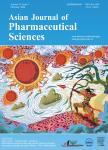Sequentially releasing self-healing hydrogel fabricated with TGFβ3-microspheres and bFGF to facilitate rat alveolar bone defect repair
Sequentially releasing self-healing hydrogel fabricated with TGFβ3-microspheres and bFGF to facilitate rat alveolar bone defect repair作者机构:Department of Cell BiologyCollege of Life Science and TechnologyJinan UniversityGuangzhou 510632China Guangdong Province Key Laboratory of Bioengineering MedicineJinan UniversityGuangzhou 510632China Biopharmaceutical R&D Center of Jinan UniversityGuangzhou 510632China Department of StomatologyJinan University Medical CollegeGuangzhou 510632China
出 版 物:《Asian Journal of Pharmaceutical Sciences》 (亚洲药物制剂科学(英文))
年 卷 期:2022年第17卷第3期
页 面:425-434页
核心收录:
学科分类:1007[医学-药学(可授医学、理学学位)] 08[工学] 0805[工学-材料科学与工程(可授工学、理学学位)] 080502[工学-材料学]
基 金:supported by grants from the Guangzhou Science and Technology Program Key Project(Grant No.201803010044) Guangdong Province College Characteristic Innovation Project(2019KTSCX011) Guangdong Province Natural Sciences Fund Project(2021A1515012480) the Key Areas Research and Development Program of Guangzhou(202103030003) Guangdong Province Special Fund Projects(Yueziranzihe,2021,No.50).
主 题:Self-healing hydrogel TGFβ3 microspheres bFGF Sequential release Alveolar defects
摘 要:Resorption and loss of alveolar bone leads to oral dysfunction and loss of natural or implant teeth. Biomimetic delivery of growth factors based on stem cell recruitment and osteogenic differentiation, as the key steps in natural alveolar bone regenerative process, has been an area of intense research in recent years. A mesoporous self-healing hydrogel(DFH) with basic fibroblast growth factor(bFGF) entrapment and transforming growth factor β3(TGFβ3)-loaded chitosan microspheres(CMs) was developed. The formulation was optimized by multiple tests of self-healing, in-bottle inversion, SEM, rheological, swelling rate and in vitro degradation. In vitro tubule formation assays, cell migration assays, and osteogenic differentiation assays confirmed the ability of DFH to promote blood vessels, recruit stem cells, and promote osteogenic differentiation. The optimum DFH formula is 0.05 ml 4ArmPEG-DF(20%) added to 1 ml CsGlu(2%) containing bFGF(80 ng) and TGFβ3-microspheres(5 mg). The results of in vitro release studied by Elisa kit, indicated an 95% release of b FGF in7 d and long-term sustained release of TGFβ3. For alveolar defects rat models, the expression levels of CD29 and CD45, the bone volume fraction, trabecular number, and trabecular thickness of new bone monitored by Micro-CT in DFH treatment groups were significantly higher than others(*P 0.05, vs Model). HE and Masson staining show the same results.In conclusion, DFH is a design of bionic alveolar remodelling microenvironment, that is in early time microvessels formed by b FGF provide nutritious to recruited endogenous stem cells, then TGFβ3 slowly released speed up the process of new bones formation to common facilitate rat alveolar defect repair. The DFH with higher regenerative efficiency dovetails nicely with great demand due to the requirement of complicated biological processes.



